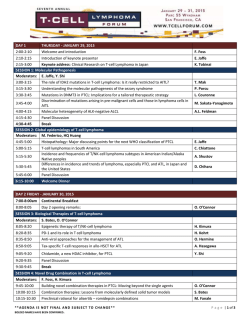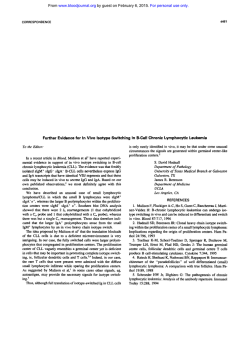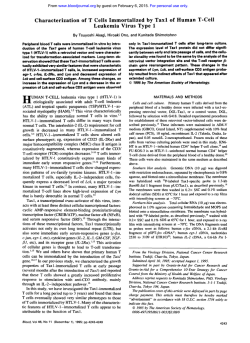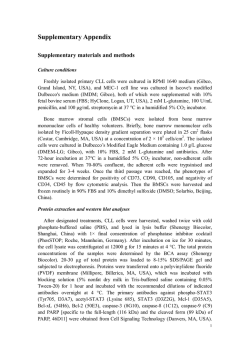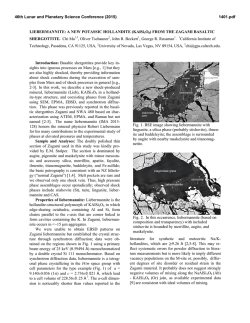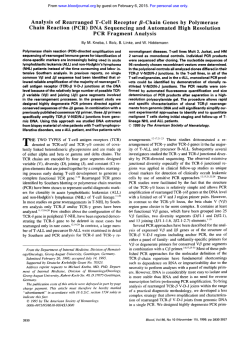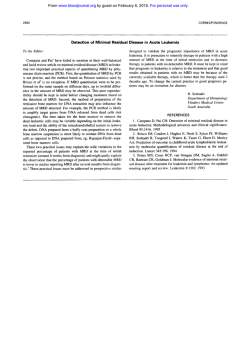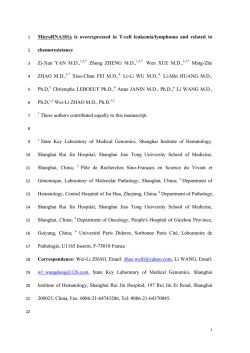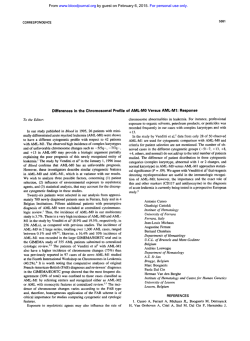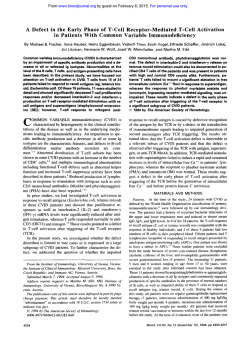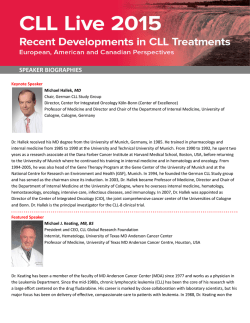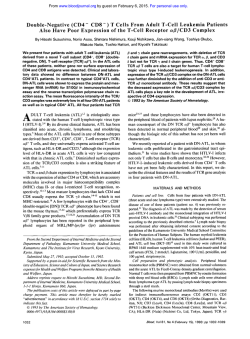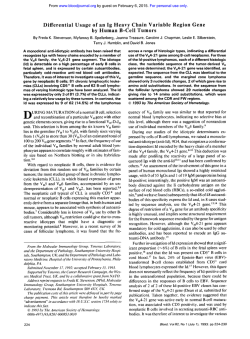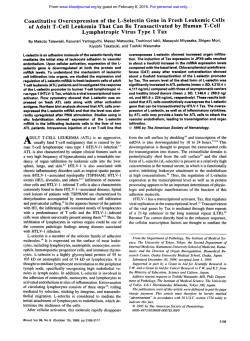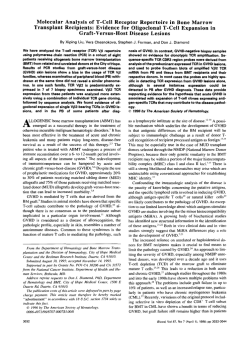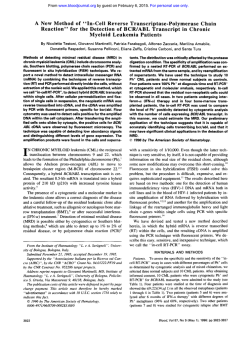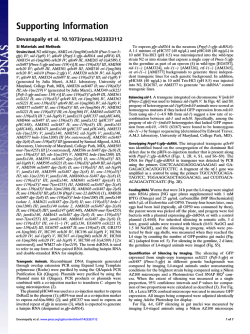
Molecular Analysis of T-cell Receptor Vp Chains of Human T
From www.bloodjournal.org by guest on February 6, 2015. For personal use only. Molecular Analysis of T - c e l l Receptor Vp Chains of Human T - c e l l Chronic Lymphocytic Leukemia Does Not Show Intraclonal Variability: Implications for Immunotherapy By Fabienne Picard, Thierry Martin, Fabienne Legras, Bruno Lioure, and Jean-Louis Pasquali Human T-cell chronic lymphocytic leukemia (T-cell CLL) is a heterogeneous disease characterized by a monoclonal malignant proliferationof T cells in which the T-cell receptors (TCRs) can be, when expressed, considered to be membrane tumor-specific antigens. Owing to the increasing number of available monoclonal antihuman TCR reagents, it could be of interest to evaluate the feasability of anti-TCR treatment during T-cell CLL. To test the therapeutic potentiality of anti-TCR monoclonal antibodies, w e first analyzed the intraclonal variability in two terminally ill patients suffering from TCRaj3-positive cell CLL bearing dif- ferent immunophenotypes. The cDNA corresponding to the variable regions of the TCRj3 chains originating from the malignant T cells were amplified, cloned into M13 phages, and sequenced. The sequence analysis of multiple independent clones showed no intraclonal variability, with no evidence for ongoing hypermutation in the Vj3 region genes. The relevance of these findings with regard to an anti-VB therapy and the comparison with similar analysis during 6-cell monoclonal lymphoproliferations are discussed. 0 1993 by The American Society of Hematology. T tic avenues depend on the intraclonal homogeneity of the TCR products bound by the malignant T cells. Confirming the known low frequency of somatic mutations affecting the VP chains bound by normal T cells,’ we found no intraclonal diversity in two patients suffering from TCRap-positive T-cell chronic lymphocytic leukemia (Tcell CLL). HE MAMMALIAN immune system is able to produce T-cell receptors (TCRs) that bind a vast array of antigenic peptides. Three mechanisms are crucial to this process of generating diversity: ( 1) the use of families of rearranging gene segments (V, D, and J regions),’ ( 2 )the combination of two polypeptide chains (a, /3, or 6) to form a functional protein,2and (3) the junctional diversity created by deletion of nucleotides, template-independent addition of nucleotides, and inverted repeats of n~cleotides.~ The resulting TCRs are highly characteristic of T-cell clones and can be considered to be clonal markers during malignant proliferations of these cells.4 In these cases, the membrane TCR, being a tumor-specific antigen, could theoretically constitute a target for a specific immune therapy. Two different approaches are possible. On one hand, the clonotypic or idiotypic approach dictates the use of antibodies directed mainly to the highly variable complementarity determining region 3 (CDR3) region of a and/or /3 chains. This first approach, although highly specific for the malignant clone, should necessitate the production of individual antibodies.$ On the other hand, an anti-VP treatment will specifically target I of the 24 VP families, not only the malignant clone, but without compromising the host immunity.6 This second approach relies on the availability of a limited number of anti-VP antibodies, and, therefore, seems technically more suitable. However, both of these theoretical therapeu- From the Laboratoire d’lmmunopathologie, Centre de Recherche d’lmmunohhnatologie, H6pital Central, and the Service d’Oncohkmatologie, H6pital de Hautepierre, H6pitaux Universitaires de Strasbourg, Strasbourg, France. Submitted January 27, 1993; accepted June 15, 1993. Supported by the Association pour la Recherche contre le Cancer and the Ligue Nationale contre le Cancer. Address reprint requests to Jean-Louis Pasquali, MD, PhD, Laboratoire d’lmmunopathologie et Unite d’lmmunologie Clinique, H6pital Central, H6pitailx Universitaires de Strasbourg, 6 7091 Strasbourg, France. The publication costs of this article were defrayed in part by page charge payment. This article must therefore be hereby marked “advertisement” in accordance with 18 U.S.C.section 1734 solely to indicate this fact. 0 I993 by The American Society of Hematology. 0006-49 71/93/820 7-0026$3.00/0 2152 MATERIALS AND METHODS Patients Patient no. 1. Patient no. I was a 59-year-old woman diagnosed 3 years ago as having a T-cell CLL on the basis of a white blood cell count showing 13,500 lymphoid cells/pL. These cells were 90% CD3+, 75% CD8+, and 86% TCRap-positive. The lymphocytosis was stable under oral chemotherapy over the last 3 years. She died of an infectious complication 3 months after the blood was withdrawn. Patient no. 2. Patient no. 2 was a 60-year-old man diagnosed as Table 1 . Oligonucleotide Primers Corresponding to Cj3 and Vg Genes TTTTGGGTGTGGGAGATCTC CCAAGCTTTTCTGATGGCTCAA ACAC GGGAATTCTTCCCTAGGTCTGGAGACCTCTCT GGGAATTCTTTCAGGCCACAACTATGTTTTG GGGAATTCGATATGGACCATGAA A ATATGTTC GGGAATTCACGATCCAGTGTCAAGTCGA GGGAATTCCTGATCAAAACGAGAGGACAGCA GGGAATTCTCAGGTGTGATCCA ATTTC GGGAATTCCAACATATGGGGCACAGGGCAATG GGGAATTCGAGGTCACAGAGATGGGACA GGGA ATTCGAACAAAATCTGGGCCATGATACT GGGAATTCGGTCCTATAAAAGCACATAGTTAT GGGAATTCTCTCAAACCATGGGCCATGACATGACAAA GGGAATTCCTGAGATGTCACCAGACTGAG GGGAATTCGCATGACACTGCAGTGTGCCC GGGAATTCACCCAAGATACCTCATCACAG GGGAATTCTCTCAGACTAAGGGTCATGATAGA GGGAATTCGACCCAATTTCTGGACATGATAAT GGGA ATTCGAACAGAATTTGAACCACGATGCC GGGAATTCAGCCCAATGAAAGGACACAGTCAT GGGAATTCACCCCCGAAAAAGGACATACTTTT GGGAATTCGAGGGAACATCAAACCCCAACCTA EcoRl and Hindlll cloning sites are underscored. These primers were shown to correctly show the main 20 Vp human families (data not shown). Blood, Vol 82, No 7 (October 1). 1993: pp 2152-2156 From www.bloodjournal.org by guest on February 6, 2015. For personal use only. 2153 V GENE EXPRESSION IN T-CELL CLL JP D VP L CP + Family specific Southern PT 22 probe primers zT9C,rl OD 128 Ci3E Fig 1. PCR-based strategy of the amplification of the variable region of the B chains. CBE, external primer; CBI, internal primer. L MgCI,) containing 10%NP40. RNA were prepared as described.R ethanol precipitated. and stored in sterile water (20 pL). having a T-cell CLL on the basis ofa white blood cell count showing 12.600 lymphocytes/pL; 93% of the cells were CD3'. 5% CD4+,9% CD8'. and 87% [email protected] clinical course was more aggressive and the patient died despite chemotherapy with central nervous system involvement 6 months after the blood sample was withdrawn. Prepururion of TCR fi C h i n cDNA To analyze the Vg gene segments. 2 pL of total mRNA was reverse transcribed into first-strand cDNA using avian myeloblastosis virus (AMV) reverse transcriptase (Molecular Genetic Resources. Tampa. FL) and a C@primer OD I28 (Table I and Fig I ) in a 50 pL reaction volume. Sorling e/ Tirmor Cdls Peripheral blood mononuclear cells were separated from heparinized blood through Ficoll Hypaque (Pharmacia. Uppsala, Sweden) sedimentation, washed three times in RPMI, and subsequently frozen in 80% RPMI 1640, IO% fetal calf serum (FCS). and IO% dimethylsulfoxide (DMSO) at -80°C until the time of the study. Cells were thawed quickly 2 hours before sorting. After washing twice in RPMI. cells were resuspended in I mL of phosphate-buffered saline (PBS)-I% bovine scrum albumin (BSA) and allowed to react with different monoclonal antibodies for single- and doublelabeling experiments: fluorescein isothiocyanate (FITC)-labeled or phycoerythrin (PE)-labeled antihuman CD4 (Dako. Glostrup. Denmark), PE-labeled antLCD8 (Dako). FITC-labeled antLCD3 (Dako), and FITC-labeled anti-pan TCRng (T Cell Diagnostics. Cambridge. MA). Cells were labeled for 30 minutes at 4°C cells. washed twice in I mL of PBS-I % RSA. and sorted on an ATC-3.000 cell sorter (ODAM. Wissembourg. France). Polvmeruse C h i n Reaction (PCR) Second-strand synthesis and amplification were performed with PCR. For the first set of PCR. we used O D 128 as a 3' end primer and 20 5'V@-familyspecific ( V a l through VP20) primers (Table 1 and Fig I ) specific for the V@genes' first framework region at a final concentration of I pmol/L each. I p L of cDNA corresponding to approximately IO' cells. and Taq DNA polymerase ( 1 U: PerkinElmer Cetus. Nonvalk, CT) or VENT polymerase ( I U: New England Biolabs, Beverly. MA) in a 50 pL reaction volume. The thermal cycler (Perkins Elmer Thermal) was set for 25 cycles with the following temperatures: melting. 94°C for I O seconds: annealing. 50°C for I minute and I5 seconds: extension. 72°C for 45 seconds. with a final extension at 72°C for 5 minutes. One microliter of the product of the first PCR was mixed with a 3' more internal CP primer, OH 29 (Table I and Fig I ) and the same 20 5'primers. The thermal cycler was set for 25 cycles (melting. 94°C for IO seconds: annealing, 65°C for 45 seconds: extension, 72°C for 45 seconds). The amplification products were analyzed on ethidium-bromidestained 1% agarose gels for 45 minutes at 100 V. Total mRNA Isolation The sorted cells were centrifuged and resuspended in cold lysis buffer ( I O mmol/L Tris-HCI. pH 7.99: IO mmol/L NaCI, 2 mmol/ MW1 rearranged Fig 2. Amplification monoclonal of V(D)J the regions of the @ chains originating from patients no. 1 (A) and 2 (E). Analysis on an ethidium bromide-stained 1% agarose gel. 2 3 4 5 6 7 8 9 1 0 11 1213 1415 16 17 1 8 1 9 2 0 " i I From www.bloodjournal.org by guest on February 6, 2015. For personal use only. PICARD ET AL 2154 52 seq VB 8.1 germline patient 1 seq 1 patient 1 seq 2 seq 3 patient 1 seq 4 patient 1 seq 5 patient 1 patient 1 seq 6 patient 1 seq 7 patient 1 Seq 8 111 Seq VB 8.1 P1 s1 P1 s2 P1 s3 P1 s4 P1 s5 P1 56 P1 57 P1 58 seq VB 8.1 P1 s1 P1 s2 P1 s3 P1 s4 P1 s5 P1 56 P1 57 P1 S8 Seq VB 8.1 P1 s1 P1 s2 P1 s3 P1 s4 P1 s5 P1 56 P1 s7 P1 S8 s1 P1 P1 P1 P1 P1 P1 P1 P1 s2 s3 s4 s5 56 s7 S8 VB 110 AAGTGACTCTGAGATGTAAACCAATTTCAGGCCACACAACTCCCT~TCTGGTACAGACAG ........................................................... ____-_______________--------------------------------------____________________--------------------------------------____________________--------------------------------------........................................................... ____-___________________________________------------------........................................................... ........................................................... VB 176 ACCATGATGCGGGGACTGGAGTTGCTCATTTACTTTAACATTTACTTTAACAAC~CGTTCCGATAGATGA~CAGGG .................................................................. .................................................................. -----------------------------------------------g------------_----- .................................................................. ---------------------------------c-------------------------------- .................................................................. -T---------------------------------------------------------------.................................................................. 177 VB 252 ATGCCCGAGGATCGATTCTCAGCTAAGATGCCT~TGCATCATTCTCCACTCTGAAGATCCAGCCC .................................................................. .................................................................. .................................................................. ___-_______---_____-____________________------------------------------------------------------------------g------------------------ ----------------------------_--------------c---------------------- -------------------------------------------c---------------------- -------------------------------------------------------G---------- 253 VB -DBTCAGAACCCAGGGACTCAGCTGTGTACTTCTGTGCCAGCAGT ........................................ A A ........................................ A ........................................ A ........................................ A A A ........................................ A ........................................ ........................................ ........................................ JB 310 CTCCTACAATGAGCAGT ____-________-____ _________________ _________________ _________________ _ _ _ _ _ _ _ _ _ _ _ L _ _ _ _ _ ____________-____ -__-----___----- 311 JB TCTTCGGGCCAGGGACACGGCTCACCGTGCTAG Fig 3. Nucleotide sequences of 8 randomly selected V(D)J regions of the monoclonal Vb originating from patient no. 1. The sequences are aligned under the germline V88.1 (EMBL data base). -------_-------_-_--------------- _________________________________ -------------------______________ ................................. ................................. --------_-_--------_------------- ................................. Southern Blot Analysis N~CI, ~~l~ were denatured in 0.5 mol/^ N ~ O Hplus 1.5 m o ] / ~ neutralized in o.5 mol/L Tris-HC1PIUS .5mol/L NaCI, and transfemed ovemiKhtin 20x ssc (sscis 3 mol/L NaC1,0,3 mol/L Na, citrate 2 H,O) to nitrocellulose filter (Nitro Plus; MSI, Westboro, MA). The membrane was put in 2X SSC for 5 minutes and then treated with UV light. The filter was then prehybndized in 5X SSC, I X Denhardt's 50% formamide, and 100 pg/mL salmon sperm DNA at 56°C for 6 hours. The filter was hybridized overnight using the same solution plus a "P-labeled CP probe, PT 22, more internal than OH 29 (Table 1 and Fig 1). Filters were washed twice for 20 minutes with 1X SSC and 0.1% sodium dcdecyl sulfate (SDS) at room temperature. Autoradiography at -80°C followed. , DNA ligase, or into pBluescript vector (Stratagene, La Jolla, CA). Single- and doubIe-stranded DNA sequencing were performed by the dideoxytermination method following the manufacturer's recommendations, using the T7 sequencing kit (Pharmacia). - Cloning and DNA Sequencing PCR products were digested with EcoRI and Hind111 restriction enzymes and ligated into M13 mp 19 sequencing vector using T4 RESULTS Tumor cell PhenotYPk C,tofluorometfic analys.s showed that patient no. 1*sTcell CLL was the result of the expansion of CD3+, CD4-, CD8+, TCRap-positive T cells. Patient no. 2's T-cell CLL was related to the expansion of CD3+, CD4-, CD8-, TCRorp-positive T cells (data not shown). Double-positive (CD3, CD8) cells were sorted from the peripheral blood lymphocytes (PBL)of patient no. 1. CD3+ cells were sorted from patient no. 2. From www.bloodjournal.org by guest on February 6, 2015. For personal use only. 21 55 V GENE EXPRESSION IN T-CELL CLL S e q VB 6 . 9 g e r m l i n e Patient 2 seq 1 Patient 2 seq 2 Patient 2 Seq 3 patient 2 Seq 4 patient 2 seq 5 49 VB 109 CAGAATGTAACTTTCAGGTGTGATCCAATTTTCTGAACACAATCC~CTTTATTGGTACCGAC ............................................................. ............................................................. ............................................................. ............................................................. ............................................................. 110 S e q VB 6 . 9 P2 s1 P2 S2 s 3 P2 s4 P2 P2 S5 ...................................................................... -----------------------------------------G---------------G-----------...................................................................... _________----___________________________---------T ------------G------------------------------------- 180 S e q VB 6 . 9 P2 s1 P2 s2 P2 s3 Fig 4. Nucleotide squences S e q VB 6 . 9 of 5 randomly selected V(D)J p2 s1 regions of the monoclonal Vj3 P2 52 s3 originating from patient no. 2. P2 The sequences are aligned under the germline Vj36.9. (EMBL data base). The substitution C to T at position 150 introduced an Hindlll site. p2 p2 P2 S1 52 s3 179 VB AGACCCTGGGGCAGGGCCCAGAGTTTCTGACTTACTTACTTCCAG~TGAA~TC~CTAG~TCAAGGCT T 249 VB G C T C A G T G A T C G G T T C T C T G C A G A G A G G C C T A A G G G A T C T G ...................................................................... ...................................................................... ---------c------------------------------------------------------------ 250 VB CAGGGGGACTCGGCCATGTATCTCTGTGCCAGCAGCTT .................................... __--________________________________ .................................... -DBJB TCCAGGGGTCG --------------------- 311 AGAGACCCAGTACTT ----------------------------- 312 JB CTGGCCAGGCACGCGGCTCCTGGTGCTCG ............................. ----________--____-__________ PCR Amplijication of the TCRp Variable Regions The cDNA originating from approximately 103 Sorted T cells and corresponding to the p chain of rearranged TCR was synthesized and amplified using the 20 5' Vp familyspecific primers (Vpl through Vp20) in combination with an internal 3t cpprimer (Fig l). The amplified products were analyzed in an ethidium bromide agarose gel. The resuits are shown in Fig 2 . The monoclonal expansions of the Vag family in patient no. 1 and 7 the Vp6 family in patient no. 2 were further confirmed by the Southern analysis using a Cp probe (data not shown). It should be mentioned that the Same amplification procedures starting from 105 sorted T cells resulted in both patients in multiple vp family bands. Ana1ysis of the Intrac1ona1variabi1ity Of the Rearranged Vp Chains To analyze the homogeneity of the Vp chains produced by the malignant T cells, we cloned the monoclonal VP-amplified products into EcoRI-HindIII-digested MI 3 mp19 phages and transformed XL Blue bacterias. We randomly selected 8 clones for patient no. 1 and 5 clones for patient no. 2 and sequenced the single-strand DNAs. Patient no. 1. The 8 rearranged V(D)J regions are reported in Fig 3. These sequences were compared with known germline sequences (EMBL data base, Heidelberg, Germany). Two ofthese sequences reached 100%homology with the Vp8. 1 germline gene.' The CDR3 regions ofthese 8 sequences were identical, proving the monoclonal origin of the rearranged Vp. Only one nucleotide could be assigned to a DO segment without N addition nor P nucleotide. Among these sequences, 6 contained one to two nucleotide changes. Patient no. 2. The 5. rearranged V(D)J regions are reported in Fig 4 and compared with known germline sequences. One Of our %quences reached loo% homo1ogy with a Vp6.9 germline gene.gFour sequences contained one or two nucleotide changes, one ofthese introducing twice an Hind111 site that shortened the HindIII-digested vp insert. The CDR3 region was longer than in patient no. 1 and Probably contained a DP 1.1 gene segment (6 nucleotides) with " and 3' N additionS. To make sure that the changes were Taq po1ymerase-induced errors, but not intraclonal mutations (clonally related mutants), we started two new preparations of PCR using either the Taq polymerase or the Vent polymerase, which has less infidelity," in patient no. 2. In these conditions, the Hind111 digestion ofthe second PCR products did not show any visible cut on an ethidium bromide-stained gel, suggesting that the changes that introduced the Hind111 site in S4 and S5 in Fig 4 were not reproducible. This was further confirmed by cloning the Vent polymerase PCR product into Bluescript and by double-stranded sequencing. The level of the changes was considerably reduced to only one nucleotide change, not existing in Fig 4, among the 6 randomly selected VDJ sequences (data not shown). DISCUSSION T-cell CLL is a heterogeneous malignant process affecting T cells bearing different immunophenotypes, mainly CD3+, CDV, CD4-.'' Some of the T-cell clones rearrange functional TCRs that, when membrane bound, can be consid- From www.bloodjournal.org by guest on February 6, 2015. For personal use only. PICARD ET AL 21 56 ered to be tumor-specific antigens. It is thus important to define the antigenic homogeneity ofthe TCR-positive malignant cells in a late stage of the disease. Despite the fact that we chose two end-stage T-cell CLL differing by their immunophenotypes, we did not find conclusive intraclonal variability. Our analysis showed only a limited number of base changes that were scattered over the Vg gene segments. We think that the base substitutions are certainly related to the infidelity of the Taq polymerase for different reasons. ( I ) Under our experimental conditions (number of cycles of PCR), the estimated error rate is not different from the experimental error rate (close to 2 for 1,000 nucleotides). (2) The majority of the substitutions appear only once, consistent with the fact that the errors occur late in amplification. (3) The vast majority ofthe changes concern A to G or C to T substitutions ( 13 of 14), which is highly suggestive of Taq polymerase introducing err0rs.~3'~ The PCR with the VENT polymerase did not reproduce the observed changes. Thus, the malignant process that affects the T cells during this type of leukemia does not induce ongoing mutations, regardless of the T-cell immunophenotype. This result is reminiscent of the known stability of the Vp chains during normal T-cell development7 and encourages anti-Vg-based immunointerventions during these diseases. On the other hand, TCR stability of T cells during ontogeny and the absence of variability during the present malignancy discourages any attempt to trace, with Vp analysis, the stage of the T-lymphoid development in which the malignant conversion took place. This stands in contrast with the results obtained during B-cell malignancies such as B-cell CLL, multiple myeloma, and follicular l y m p h ~ m a , ' ~in - ' ~which the differences of the expressed variable region genes of the monoclonal Ig and the corresponding germline genes, as well as the intraclonal variability, can serve as markers of the stage in which the malignancy occurs. REFERENCES 1. Sin G, Clark SP, Yoshikai Y, Malissen M, Ganag Y, Strauss E, Mak TW, Hood L: The human T cell antigen receptor is encoded by variable, diversity and joining gene segments that rearrange to generate a complete V gene. Cell 37:393, 1984 2. Saito H, Kranz DM, Takagaki Y, Hayday MC, Ersen HN, Tonegawa S: Complete primary structure of a heterodimeric T-cell receptor deduced from cDNA sequences. Nature 309:757, 1984 3. Lieber MR: The mechanism of V(D)J recombination: A balance of diversity, specificity and stability. Cell 70:873, 1992 4. Foa R, Pelicci PG, Migane N, Lauria F, Pizzolo G, Flug F, Knowles DM, Dalla-Favera R: Analysis of T-cell receptor beta chain (TO) gene rearrangements demonstrates the monoclonal nature of T-cell chronic lymphoproliferative disorders. Blood 67:247, 1986 5. Janson CH, Tehrani MJ, Mellstedt H, Wigzell H: Anti-idiotypic monoclonal antibody to a T-cell chronic lymphatic leukemia. Cancer Immunol Immunother 28:225, 1989 6. Kanagawa 0: In vivo T-cell tumor therapy with monoclonal antibody directed to the V@chain of T-cell antigen receptor. J Exp Med 170:1513, 1989 7. Ikuta K, Ogura T, Shimizu A, Honjo T: Low frequency of somatic mutation in @-chainvariable region genes of human T-cell receptors. Proc Natl Acad Sci USA 82:7701, 1985 8. Maniatis T, Fritsch EF, Sambrook J: Molecular Cloning. Cold Spring Harbor, NY, Cold Spring Harbor Laboratory, 1989 9. Kimura N, Toyonaga B, Yoshikai Y, Du RP, Mak T W Sequences and repertoire of the human T-cell receptor 01 and 0 chain variable region genes in lymphocytes. Eur J Immunol 17:375, 1987 10. Mattila P, Korpela J, Tenkanen T, Pitkilnen K: Fidelity of DNA synthesis by the Thermococcus litoralis DNA polymeraseAn extremely heat stable enzyme with proofreading activity. Nucleic Acids Res 19:4967, 1991 11. Bennet JM, Catovsky D, Daniel MT, Flandrin G, Galton DAG, Gralnick HR, Sultan C: The French-AmencawBritish (FAB) Cooperative Group: Proposals for the classification of chronic (mature) B and T lymphoid leukaemias. J Clin Pathol 42367, 1989 12. Ennis PD, Zemmour J, Salter RD, Parham P: Rapid cloning of HLA-A, B cDNA by using the polymerase chain reaction: Frequency and nature of errors produced in amplification. Proc Natl Acad Sci USA 87:2833, 1990 13. Meeker TC, Grimaldi JC, O'Rourke R, Loeb Y, Juliusson G, Einhorn S: Lack of detectable somatic hypermutation in the V region of the IgH chain gene of a human chronic B lymphocytic leukemia. J Immunol 141:3994, 1988 14. Kipps TJ, Tomhave E, Chen PP, Carson DA: Autoantibodyassociated kappa light chain variable region gene expressed in chronic lymphocytic leukemia with little or no somatic mutation. Implications for etiology and immunotherapy. J Exp Med 167:840, 1988 15. Bakkus MHC, Heinnan C, Van Riet I, Van Camp B, Thielemans K: Evidence that multiple myeloma Ig heavy chain VDJ genes contain somatic mutations but show no intraclonal variation. Blood 80:2326, 1992 16. Levy R, Levy S, Cleary M, Carrol W, Kon S, Bird J, Sklar J: Somatic mutation in human B-cell tumors. Immunol Rev 96:43, 1987 From www.bloodjournal.org by guest on February 6, 2015. For personal use only. 1993 82: 2152-2156 Molecular analysis of T-cell receptor V beta chains of human T-cell chronic lymphocytic leukemia does not show intraclonal variability: implications for immunotherapy F Picard, T Martin, F Legras, B Lioure and JL Pasquali Updated information and services can be found at: http://www.bloodjournal.org/content/82/7/2152.full.html Articles on similar topics can be found in the following Blood collections Information about reproducing this article in parts or in its entirety may be found online at: http://www.bloodjournal.org/site/misc/rights.xhtml#repub_requests Information about ordering reprints may be found online at: http://www.bloodjournal.org/site/misc/rights.xhtml#reprints Information about subscriptions and ASH membership may be found online at: http://www.bloodjournal.org/site/subscriptions/index.xhtml Blood (print ISSN 0006-4971, online ISSN 1528-0020), is published weekly by the American Society of Hematology, 2021 L St, NW, Suite 900, Washington DC 20036. Copyright 2011 by The American Society of Hematology; all rights reserved.
© Copyright 2025

